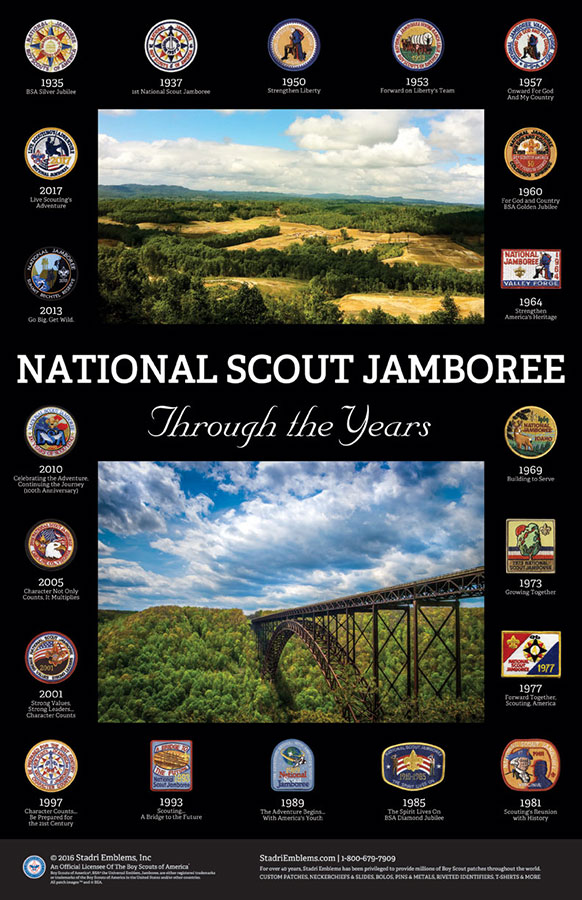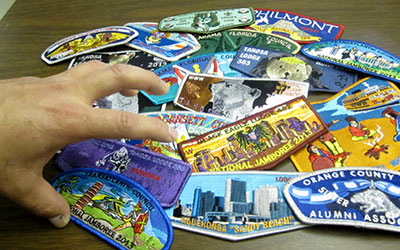The National Scout Jamboree is a gathering held every four years of thousands of members of the Boy Scouts of America.
Referred to as "the Jamboree," "Jambo," or NSJ, it is attended by Scouts all over the country. Attendees participate in sports and educational activities, as well as well-established Jamboree traditions such as patch trading, camping, and stadium shows.
Join us as we outline every National Scout Jamboree, starting with the very first Silver Jubilee in 1935, right up to the 100th Anniversary of BSA in 2010.
1935 National Scout Jamboree Patch
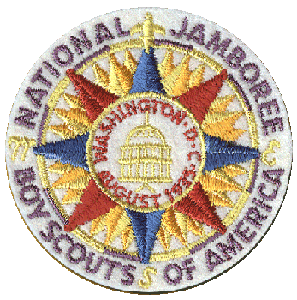 The first "Silver" Jamboree was scheduled to be held in 1935 in Washington, D.C. to celebrate the 25th anniversary of Scouting, but was delayed two years due to a Polio epidemic. However, the patch was still issued and a quality reproduction can be seen here.
The first "Silver" Jamboree was scheduled to be held in 1935 in Washington, D.C. to celebrate the 25th anniversary of Scouting, but was delayed two years due to a Polio epidemic. However, the patch was still issued and a quality reproduction can be seen here.
The patch featured two different shades of gold thread with the outer lettering in purple. The dome of the nation's capital building is featured in the center. These special boy scout patches were originally issued in small wax paper bags.
1937 National Scout Jamboree Patch
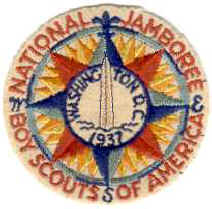
On June 30th, 1937 The first National Jamboree was held in Washington, DC at the invitation of President Roosevelt. 536 Councils were represented at this important moment in the history of Scouting.
The patch for the first National Jamboree featured the compass design, much like the 1935 issue, however, instead of the capital's dome in the center, the Washington monument stood as the center point, its tip in line with the fleur de lis that points North. The National Jamboree coincided with the 5th World Scout Jamboree held in the Netherlands on the same year.
1950—The National Scout Jamboree Returns
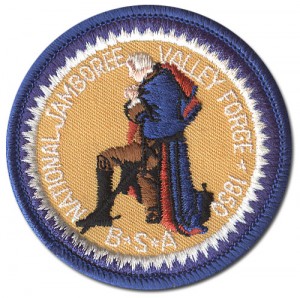
After getting off to a great start in 1937, the Scout Jamboree was disrupted for more than a decade by World War II. It finally returned in 1950, at a new location, Valley Forge, Pennsylvania. The theme that year was "Strengthen Liberty."
The patch for that year depicted George Washington kneeling in prayer inside a decorative blue and white border. The embroidered patch coincided with a dramatic pageant about Valley Forge that was performed during the Jamboree.1953—Scouts Head West for National Jamboree
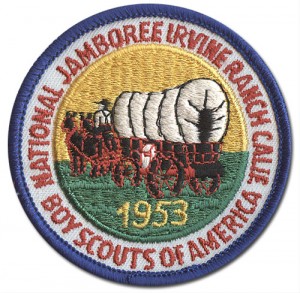
The 1953 Scout Jamboree, held on Irvine Ranch in Orange County California, marked the first time a national Scout gathering had ever been held in the western United States.
To accommodate the gathering of 50,000 plus scouts, The Irvine Company cleared and leveled land to create a "Jamboree City" located just North of the Pacific Coast Highway.
The patch for that year featured a pioneer heading West in a covered wagon. The wagon and horses were outlined in a deep red thread that matched the wording stitched around the circular border. The image of the wagon was set against a backdrop of green land and a golden horizon as seen here in this commemorative reproduction.
1957 National Scout Jamboree Returns to Valley Forge
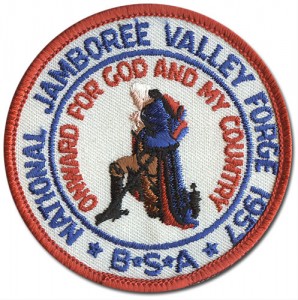
1957 marked a return to Valley Forge, Pennsylvania for the Scout Jamboree, resulting in the highest attendance (52,580) a Jamboree had achieved yet.
The patch for that year saw a smaller version of the kneeling George Washington in the center with that year's theme "Onward for God and My Country" embroidered in a semi-circle around him. Unlike previous Jamboree patches, there was no gold thread, but the red, white, and blue of the American flag made up the color scheme of the patch. Here you can see the patch from the 1957 event.
1960 Scout Jamboree—The Boy Scout's Golden Year
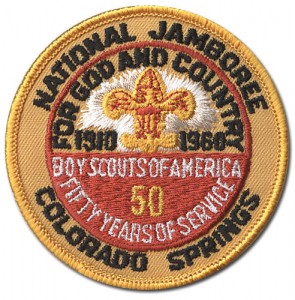
Colorado Springs was the location the Scouts chose to celebrate their 5th National Jamboree and part of their 50th "Golden Jubilee" Anniversary. For this reason, the Jamboree was moved up a year. A dramatic flag raising representing 50 states took place in the morning, followed by fireworks. A flyover demonstration by the Navy's famous "Blue Angels" also highlighted this historic event.
Trading was abundant; In addition to patches, items as diverse as neckerchiefs and slides, knives, leatherwork, etchings, pottery, and even horned toads from Texas Scouts all exchanged hands. The patch that year was a rich golden color with an embroidered universal emblem emanating from the center with that year's theme "For God and Country" embroidered over top.
1964 National Scout Jamboree—Third Time in Valley Forge
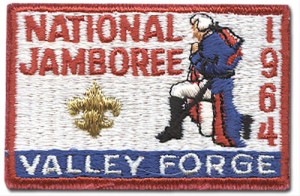
"Strengthen America's Heritage" was the theme for this Jamboree. The Scouts participated in a showcase of Scouting skills, such as camping, demonstrating how the knowledge a Scout acquires can help strengthen the country's heritage and pass it down to future generations.
The custom patch for that year was a rectangular pocket patch featuring Washington, a fleur-de-lis embroidered in gold thread, on a predominately white patch with red and blue accents.
1969 National Scout Jamboree—Play the Game, Earn a Patch
The Jamboree in 1969 took place in Farragut State Park, Idaho and featured a popular Jamboree-Wide Game. If a Scout successfully completed the game, he earned a strip with the "Building To Serve" logo that could be added to the bottom of the Jamboree pocket patch for that year. The yellow patch featured an embroidered deer and a gold fleur-de-lis. With its beautiful nature scene, this was the most detailed Jamboree Patch to date.
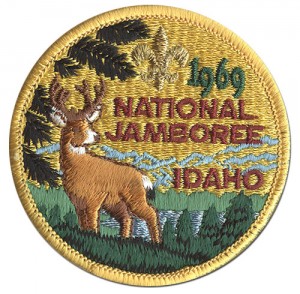
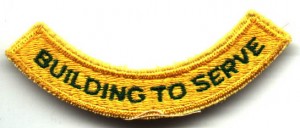
1973 National Scout Jamboree—Boy Scouts Divide to Grow Together
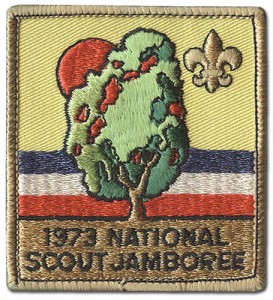 This National Scout Jamboree took the novel approach of splitting the Scout contingent between a "Jamboree East" in Moraine State Park, Pennsylvania and "Jamboree West" in Farragut State Park, Idaho.
This National Scout Jamboree took the novel approach of splitting the Scout contingent between a "Jamboree East" in Moraine State Park, Pennsylvania and "Jamboree West" in Farragut State Park, Idaho.Jamboree West featured activities such as "punt-pass-and kick" and "horseshoes" with a "Merit Badge Midway" and "Trading Post Warehouse."
Jamboree East was hosted by the newly formed Moraine Trails Council—a merger of the former Lawrence County and Pioneer Trails Councils.
Whichever site National Councils decided to attend, they readied themselves for three exciting weeks of Scouting activities.
The combined attendance of the Jamboree sites was 73,610 Scouts. The two sites were unified by this Jamboree pocket patch of a tree and gold fleur-de-lis in the foreground of a red setting sun, and red, white, and blue stripes. Blue Neckerchiefs featuring the tree were also distributed at the sites.
1977 National Jamboree at "More-Rain" State Park
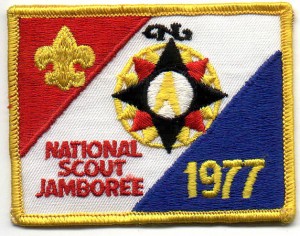
In 1977, 28,000 Scouts set up camp in a valley of Moraine State Park and then the floods came. 4 1/2 Inches of rain soaked the Jamboree site in two days, causing more than just wet socks and sleeping bags. In some places, the mud was 4 inches deep with standing water reaching up another 2 inches. However, the Scouts didn't let the soggy surroundings dampen their spirits. There were plenty of Scout competitions and one of the largest campfires ever. Burl Ives and Bruce Jenner were also rumored to have been in attendance for a portion of the 10 day event.
The patch that year was simpler than the last two Jamborees, but featured a compass and fleur over a diagonally striped background. The traditional red, white, blue, and gold colors were also used in the design.
1977 National Boy Scout Jamboree(YouTube video courtesy of celakip)
1981 Scout Jamboree—The Scouts Find a Home
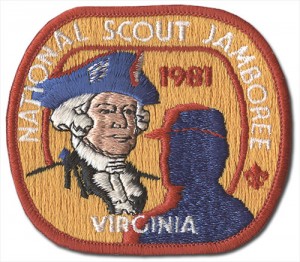
In 1981 Scouts descended up Fort A.P. Hill, Virginia to hold their Jamboree at the site that would become the Jamboree location for the next 29 years.
The theme for that year's Jamboree was "Scouting's Reunion with History" and much of the programming focused on America's heritage. There were performances by the Marine Corps Drum and Bugle team, the U. S. Naval Academy Band, as well as, a Youth Jamboree band made up of 120 Scouts from councils all over the country. King Carl Gustaf of Sweden was a VIP attendee.
Winds as high as 50 mph were reported on the last day, but, by all accounts, this was a safe and fun Jamboree event.
The pocket patch for that year featured an embroidered Washington framed by a Scout in blue silhouette. A red-fleur-de-lis hangs over the Scout's right shoulder and the patch is a yellow gold color with a red merrowed border.
1985 National Scout Jamboree—Scouting and Diamonds are Forever
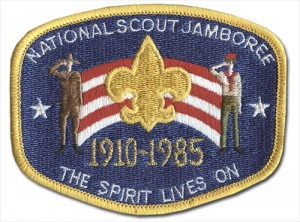
In 1985 the Scouts celebrated their 75th "Diamond" Anniversary. The Jamboree was part of the year-long Diamond Jubilee celebration. There was cause to celebrate as the eighties marked a lot of upgrades and modernizations to the Scouting movement.
The new Oscar de la Renta designed uniform premiered in 1980, Tiger Cubs had been formed in 1982 as a program for seven-year old boys.
1984 brought on extended camping and uniform privileges for Webelos and the Jamborees of the eighties marked the first time computers were used to organize and inform councils about the schedule of the events.
The shift into the modern era was reflected in the 1985 Jamboree patch, featuring a saluting Scout clad in the old uniform on the left and connected by a fleur-de-lis and stripes of the flag to a modern saluting Scout on the right.
The theme for that year's Jamboree was "The Spirit Lives On." In addition to the pocket patch, attending Scouts received a neckerchief, regional jacket patch, two special region hat pins, and a travel bag.
The Jamboree covered a 9 mile area of the active Army base and set-up was handled and used as simulated disaster relief training by the Army Corps of Engineers.
1989 National Scout Jamboree—Presidential Praise and Spaceships
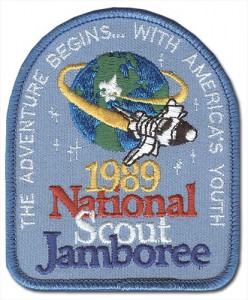
The 12th National Scout Jamboree took place at Fort A.P. Hill and featured newly-elected President George H.W. Bush stepping out of Marine One to address the Scouts, praising them for their leadership and role in confronting the problem of drug abuse.
"You are teaching self-protection strategies against drugs and other dangers," President Bush said.
The patch for 1989's Jamboree featured a space shuttle to match the theme of that year's most popular attraction, a huge NASA exhibit that featured mock versions of rockets and other space craft for the Scouts to explore.
To welcome NASA, the scouts organized their 32,717 attendees into 20 subcamps, each one named after a different space mission. This marked the first year that Scouts used propane stoves in the campsites, and the first female-registered campers attended a jamboree-22 members of Post 1425 from Wilmington, Delaware. As the Scouts were poised to say goodbye to the 80's and welcome in a new decade, there were clearly many new challenges and adventures awaiting them.
1993 Scout Jamboree—The View from the Bridge

The '93 Jamboree was attended by 34,449 scouts who were organized into four regional encampments. Among the activities Scouts participated in were: Air Rifle, "Bikathelon," Archery, "Buckskin Games," a "Confidence" course, and Motocross. An amateur radio station was among the featured exhibits.
Friday afternoon's activities were canceled due to major rain and localized flooding.
The patch for that year featured an image of Scouts standing on a bridge, framed by the theme "A Bridge To The Future." A daily newspaper entitled "Jamboree Today" was distributed to all of the camps, informing them of each day's events at this jamboree. This was also the year that the first Russian Scout Handbook was developed with help from the BSA.
1997 National Scout Jamboree—Character Counts

The '97 Jamboree returned to Fort A.P. Hill, outside of Fredericksburg, Virginia with the goals of giving Scouts and leaders a clear understanding and a deeper sense of commitment to the ideals of Scouting, demonstrating to America and the world that camaraderie and the objectives of a great youth movement in a free society can be attained, even during a huge gathering, emphasizing physical fitness and conservation of natural resources in today's world, and establishing and promoting Scouting activities and methods that will find their way into the program of troops throughout the nation.
Activities included scuba diving and conservation. The Patch for that year's Jamboree marked a return to tradition and style of the first Jamboree patches. The compass logo was surrounded by a golden merrowed border with the reminder to "Be Prepared For The 21st Century" embroidered around the top.
2001 National Scout Jamboree—First of a New Decade

The 2001 Scout Jamboree will be long remembered for ushering the Scout Movement into the new millennium. This was also the last Jamboree that took place in a pre-911 America. There was a large American Indian Village, featuring native american dancing and crafts. Scouts could interact with Scouting's values like never before in the technologically advanced "Scoutopia" exhibit. The Outdoor Adventure Place that year focused on sustainability with information and demonstrations on "Leave No Trace" camping.
The round pocket patch for that year introduced the color black to the red, white, blue, and gold elements and featured the phrase "strong values, strong leaders" along the bottom. This was the focus added to the "character counts" motto of the last few years.
2005 Scout Jamboree—Rockers, Explorers, and a "Death March"
 The 2005 National Scout Jamboree was so well attended it raised Caroline County from the 50th most populated county in Virginia to the 14th for the duration of the event. The Jamboree organized Scouts into 20 sub-camps, each one named after a living American explorer.
The 2005 National Scout Jamboree was so well attended it raised Caroline County from the 50th most populated county in Virginia to the 14th for the duration of the event. The Jamboree organized Scouts into 20 sub-camps, each one named after a living American explorer.
The Jamboree was not without its trials however, extreme heat caused problems for some, with many Scouts being treated for symptoms of heat exhaustion and heat stroke. A long, sweltering walk back to camp was dubbed "The Death March" by some Scouts.
While the elements tested their mettle, competition was fierce for the five activity patch "rockers" that could be earned for completing various challenges from the Action Centers, Outback Centers, Activities, Duty to God and a 5-K run. The rockers fit around the official patch for that year, creating a stunning patch any Scout in attendance would have been proud to display. For the finest Official Scout Patches, Neckerchiefs and more visit: Stadri Emblems Scouting Site
2010 Scout Jamboree—BSA's 100th Anniversary and Fort A.P. Hill Goes Out With a Bang
 Three significant milestones marked the 2010 National Scout Jamboree, as scouts celebrated the 100th anniversary of BSA. It was the last jamboree held at Fort A.P. Hill and was the largest Jamboree overall since 1973, with more than 50,000 in attendance.
Three significant milestones marked the 2010 National Scout Jamboree, as scouts celebrated the 100th anniversary of BSA. It was the last jamboree held at Fort A.P. Hill and was the largest Jamboree overall since 1973, with more than 50,000 in attendance.
The patch for that year appropriately featured the 100th anniversary of Scouting, and the theme, Celebrating the Adventure, Continuing the Journey, perfectly represented the past, present, and future of Scouting.
National Scout Jamboree Through the Years Wall Poster
If the history of Jamboree is as intriguing to you as it is to us, you may enjoy having this one-of-a-kind, 11 x 17" wall poster—designed and sold exclusively by Stadri Emblems—hanging in your lodge or office, or with your patch collection. Check it out!
